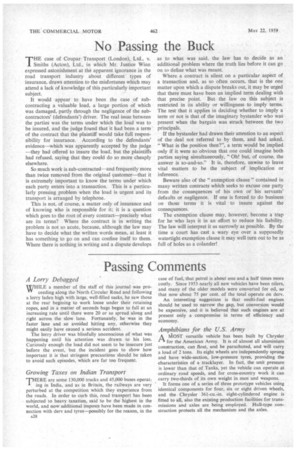Passing Comments
Page 30

Page 31

If you've noticed an error in this article please click here to report it so we can fix it.
A Lorry Debagged
WHILE a member of the staff of this journal was proceeding along the North Circular Road and following a lorry laden high with large, well-filled sacks, he saw those at the rear begining to work loose under their retaining ropes, and in a matter of seconds bags began to fall at an increasing rate until there were 20 or so spread along and right across the slow lane. Fortunately, he was in the faster lane and so avoided hitting any, otherwise they might easily have caused a serious accident.
The lorry driver was blissfully unconscious of what was happening until his attention was drawn to his loss. Curiously enough the load did not seem to be insecure just before the event, but the incident goes to show how important it is that stringent precautions should be taken to avoid such episodes, which are far too frequent.
Growing Taxes on Indian Transport
THERE are some 130,000 trucks and 45,000 buses operating in India, and as in Britain, the railways are very perturbed at the competition which they experience from the roads. In order to curb this, road transport has been subjected to heavy taxation, said to be the highest in the world, and now additional imposts have been made in connection with dery and tyres—possibly for the reason, in the A28 case of fuel, that petrol is about one and a half times more costly. Since 1953 nearly all new vehicles have been oilers, and many of the older models were converted for oil, so that now about 75 per cent, of the total operate on derv.
An interesting suggestion is that multi-fuel engines should be used to narrow the gap, but conversion would be expensive, and it is believed that such engines are at present only a compromise in terms of efficiency and economy.
Amphibians for the U.S. Army
A•OST versatile vehicle has been built by Chrysler for the American Army. It is of almost all aluminium construction, can float, and be parachuted, and will carry a load of 2 tons. Its eight wheels are independently sprung and have wide-section, low-pressure tyres, providing the characteristics of a tracklayer. In fact, the unit pressure is lower than that of Tanks, yet the vehicle can operate at ordinary road speeds, and for cross-country work it can _carry two-thirds of its own weight in men and weapons.
It forms one of a series of three prototype vehicles using identical components for four, six or eight driven wheels, and the Chrysler 361-cu.-in. eight-cylindered engine is fitted to all, also the existing production facilities for transmissions and axles are being employed. Hull-type construction protects all the mechanism and the axles.
Fuel Oil Below. Cost .
AN interesting view about the competition with coal by fuel oil, which was dealt with in two articles in The Commercial. Motor dated April 3 and 10, is that expressed by Viscount Alois Van de Vyvere, chairman of Petrofina, S.A., in his annual report. The company sell Fina petroleum products in this country through Petrofina (Great Britain), Ltd.
Whereas the decline in the use of coal in Britain has been partly caused by the greater consumption of fuel oil, often because oil is cheaper in many instances, Viscount Van de Vyvere say's that the competition between coal and fuel oils which has occurred in Many countries is unjustifiable.
"The prices at which fuel oil has been, and is still being, sold in certain European markets result in the oil companies sustaining losses out of all proportion to the possible ,increase of their outlets This policy provokes the natural reaction from the governments and from the coal industry in the countries where it has, been followed," he States. •
The consequences of selling fuel oil below cost were particularly harmful: Fuel oil could not be regarded as .a residual product.
A Plaice in the Sun
A N object which has for some time been an eyesore in a " by-road in which lives a reader of this journal is the skeleton, covered in dust but still intact, of a very large
plaice. Dustmen conduct their weekly collections of rubbish with commendable regularity, other men, pre
re sumably
sumably road cleaners, appear from time to time, but the skeleton seems tobe studiously avoided by all.
The• reader concerned now wishes ,to know whether it will require a trades union conference to decide who shall dispose of it. In the end it will probably be by sonic methodical .citizen, possibly a mortician, who might then be asked if he has a "card."
An American Report on Safety
A WRITER to Transport Topics of Washington, refer" ring to the accident problem as it affects goods vehicles says that much of this can be. overcome by better training and control. Many of such models are bulky and thus present a greater exposure to collisions, such as side-swipes. Their size also makes them rather less manceuvrable,and thus they have: difficulty in avoiding a collision once it threatens.
An important, point is that their lower power-to-weight ratio makes them lOse speed on gradients, and they are thus more susceptible to head-on collisions. It is therefore most advisable that they should not overtake other vehicles, particularly commercial models, on hills when they Would be travelling only a few miles an hour faster.
Most of the writer's suggestions come from a report to Congress made by the Bureau of Public Roads. A suggestion in this is that on hills of any appreciable length there should be a near-side lane for slow traffic. Another problem almost unique to these vehicles is said to be that of varying bumper heights, whilst safe loading and the effective anchoring of loads to protect the driver are other points' raised.


































































































